
Canon EOS 35-350
by Philip Greenspun; created 1995
Site Home : Photography : Canon EOS 35-350
The Canon EOS 35-350L USM zoom lens gets me a lot of pictures that I otherwise wouldn't have gotten. What more can you ask from a lens?
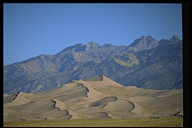 For a couple of years,
I'd gotten into a rut of carrying one Nikon with a 20/2.8 mounted, another Nikon
body with an 80-200/2.8 mounted, and a 60 macro in my pocket. I hardly ever took
any pictures with the 60 because I thought I liked the dramatic perspectives
offered by the other focal lengths; it turned out that I was really just too lazy
to change lenses.
For a couple of years,
I'd gotten into a rut of carrying one Nikon with a 20/2.8 mounted, another Nikon
body with an 80-200/2.8 mounted, and a 60 macro in my pocket. I hardly ever took
any pictures with the 60 because I thought I liked the dramatic perspectives
offered by the other focal lengths; it turned out that I was really just too lazy
to change lenses.
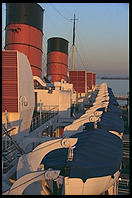 By moving myself back and forth and zooming the 35-350, I very quickly settle
in on my favorite framing and perspective. It turned out that I was a closet 50mm
lover but didn't realize it. Oftentimes I look down to see what focal length I've
chosen and it is in the 35-70 that I'd always ridiculed.
By moving myself back and forth and zooming the 35-350, I very quickly settle
in on my favorite framing and perspective. It turned out that I was a closet 50mm
lover but didn't realize it. Oftentimes I look down to see what focal length I've
chosen and it is in the 35-70 that I'd always ridiculed.
Above right: Great Sand Dune National Monument in Colorado, part of my Footsteps travelogue.
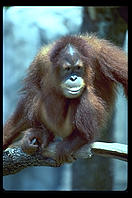 "What kind of brain dead
person uses program autoexposure?" I always wondered to myself. Now I am one.
With an 80-200, you generally know that you're taking portraits and aperture
priority at f/4 is the right thing, or maybe it is sports and shutter priority
1/500th is the right thing. With a 35-350, though, appropriate shutter speeds are
all over the map and it is much more efficient to let the camera pick a starting
aperture/shutter speed combo then dial in with the top wheel (for program shift)
and the back wheel (for exposure compensation).
"What kind of brain dead
person uses program autoexposure?" I always wondered to myself. Now I am one.
With an 80-200, you generally know that you're taking portraits and aperture
priority at f/4 is the right thing, or maybe it is sports and shutter priority
1/500th is the right thing. With a 35-350, though, appropriate shutter speeds are
all over the map and it is much more efficient to let the camera pick a starting
aperture/shutter speed combo then dial in with the top wheel (for program shift)
and the back wheel (for exposure compensation).
Now I always switch to program mode when I mount the 35-350.
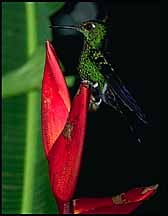 Size and weight are about
the same as an 80-200/2.8, i.e., three pounds (1.5 kg) and big. Racked out to 350
with the sunshade, enormously long. Aperture sticks around f/3.5 until 70mm then
moves to f/4.5 until about 160mm and doesn't degrade to f/5.6 until you're in the
200-350 range. EOS camera finders/screens make it tough to focus manually even
with f/2.8 wide angles so be prepared for difficult focusing from 35 to 50mm.
Size and weight are about
the same as an 80-200/2.8, i.e., three pounds (1.5 kg) and big. Racked out to 350
with the sunshade, enormously long. Aperture sticks around f/3.5 until 70mm then
moves to f/4.5 until about 160mm and doesn't degrade to f/5.6 until you're in the
200-350 range. EOS camera finders/screens make it tough to focus manually even
with f/2.8 wide angles so be prepared for difficult focusing from 35 to 50mm.
The lens doesn't focus especially close, so it is nice to carry an extension tube. The hummingbird at left was at 200mm with extension tube, f/11 and on-camera flash. Fuji Velvia. (from my Costa Rica travelogue)
Mechanical quality is excellent and, although the weight of the lens will cause "unintended zooming" if you have it pointing down, there is a tension/locking ring that lets you prevent focal length drift.
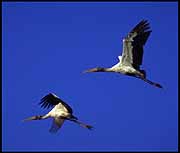 For $2000, you're
going to get a decent snapshot out of a lens. Is it really as contrasty as a
70-200/2.8? No. As sharp as a 300/2.8 at 300? No. But who cares? Any picture
would be a lot better if you'd only had your 8x10 view camera handy, but you
never would have so you don't even dream about it. Why then dream about how much
better a shot you could have gotten with that 300/2.8 or 105/1.8. You weren't
going to carry them out on the street where you thought you'd be photographing at
35mm most of the time.
For $2000, you're
going to get a decent snapshot out of a lens. Is it really as contrasty as a
70-200/2.8? No. As sharp as a 300/2.8 at 300? No. But who cares? Any picture
would be a lot better if you'd only had your 8x10 view camera handy, but you
never would have so you don't even dream about it. Why then dream about how much
better a shot you could have gotten with that 300/2.8 or 105/1.8. You weren't
going to carry them out on the street where you thought you'd be photographing at
35mm most of the time.
The 35-350 takes publication quality images. Just keep the lens hood on and watch for flare. Bring a tripod and stop down if you're really paranoid.
At right: Wood storks in Costa Rica, 350 and f/5.6, autofocus. Fuji Sensia. Cropped.
Or "random snapshots". Take your pick.
Here are some from Cape Cod
From my trip from Boston to Los Alamos and back
From Oregon...
Text and pictures copyright 1991-1995 Philip Greenspun. Top photo from California.